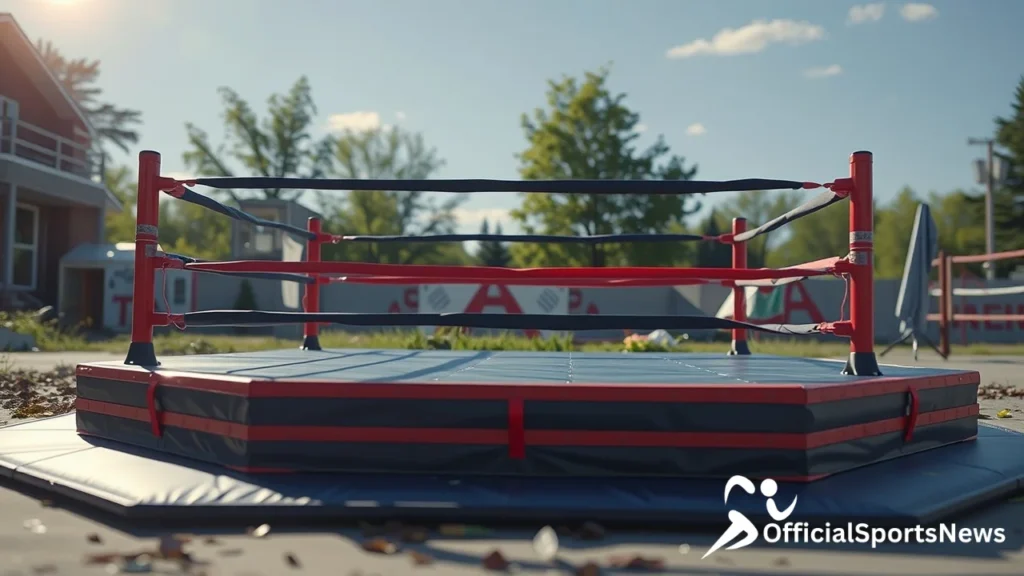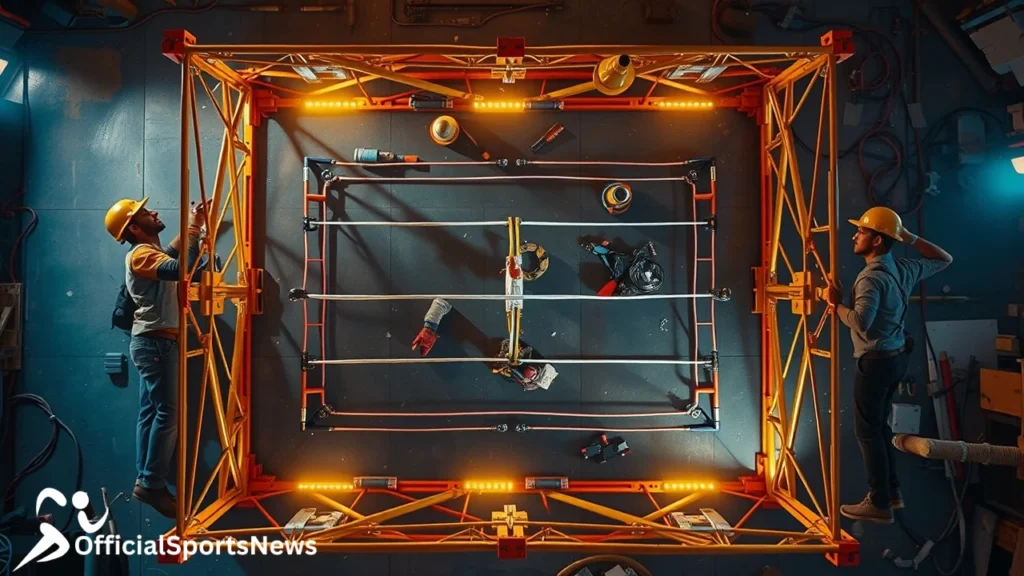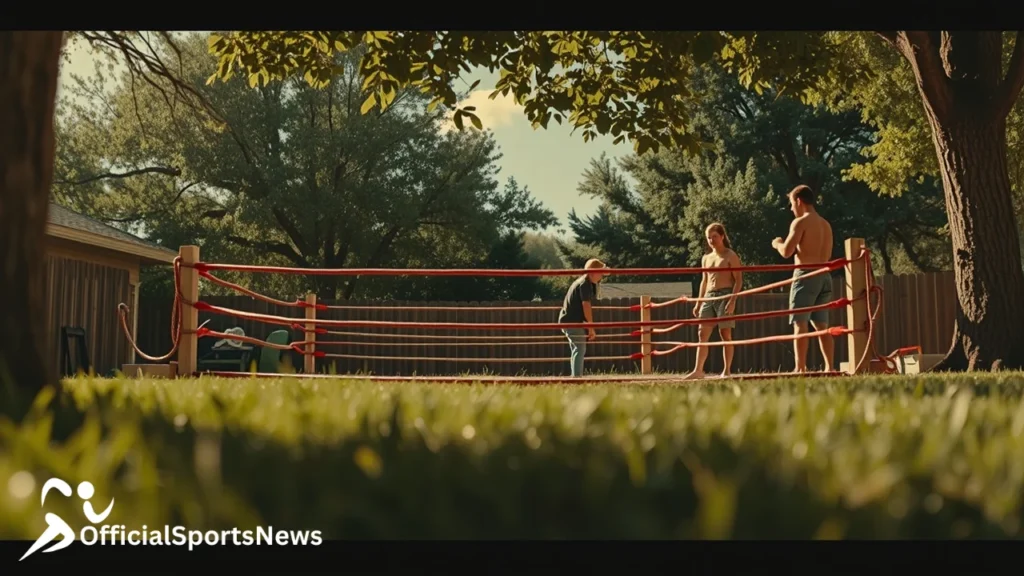The rings are undoubtedly exciting if you consider professional wrestling events. Rings for wrestling are the arena where wrestlers display their abilities and entice people worldwide. If you’re a fan who wants to be a wrestler or is considering making your ring, knowing the intricate details of the wrestling ring is vital. From the types and sizes of rings to the steps for setting up, the guide will explain all you’ll need to learn about wrestling rings.
What is a Wrestling Ring?
A wrestling ring is a specially designed platform for professional wrestling competitions. In contrast to boxing rings, they are specifically designed to accommodate high-impact moves and provide a safe and secure space for wrestlers. They’re made of padding, strengthened materials, and ropes that can meet the physical demands of wrestling. They also protect wrestlers.

Read More Article: Iowa Wrestling: Excellence in Collegiate Wrestling
Types of Wrestling Rings
Rings for wrestling are available in various designs, and each can be customized to fit a particular type of wrestler or needs to perform. They can be classified into three categories:
Professional Wrestling Rings
They are among the most popular models used for promotions such as WWE or AEW. They have sturdy frames made of steel, wooden planks, thick padding, and padding surfaces. They are made for maximal durability and appeal to the audience.
Training Rings
Training rings are smaller versions of wrestling mats equipped with padding to reduce any chance of injury during practice sessions. Athletes looking to transition into grappling often utilize training rings to develop their abilities further.
Backyard Wrestling Rings
These homemade or DIY rings are best for casual grapplers or backyard enthusiasts as they are less durable and won’t accommodate more intense movements.
Portable Wrestling Rings
Constructed for ease of use, these mobile wrestling rings can be easy to assemble and take down. They’re ideal for traveling promotional events and other temporary ones.
Custom Wrestling Rings
A few wrestling groups or even individuals purchase custom-made rings that meet specific dimensions, styles, or brand requirements.
Wrestling Ring Sizes
Dimensions of the arena are essential for its performance and usability. We’ll take a look at the most standard sizes.
Professional Wrestling Rings
- Standard Size: 20 ft x 20 ft (outer dimensions)
- Major promotions like WWE and AEW use it.
- You can perform intricate moves and performances.
Training Rings
- Size: 16 ft x 16 ft or 18 ft x 18 ft
- Its smaller size makes it perfect for training and developing skills.
Backyard Rings
- Size: varies, typically about 12 feet by 14 feet 14 feet.
- Created for use in casual settings with less structural requirements.
Portable Rings
- Size: Usually between 16 feet x 16 feet or 18 feet x inches.
- It is small and light, making it easy to transport.
Custom Rings
- Size: Adaptable to suit the needs of your business.
- It may include branding or unique features like additional padding or paddingjustable ropes.
Key Components of Wrestling Rings
Every ring for wrestling has many essential elements that guarantee their safety and effectiveness:
Frame
The frame is usually composed of aluminum or steel to ensure durability. It acts as the basis of the band.
Canvas
This is the primary layer where wrestling occurs. This is usually made from rigid materials that can withstand wear.
Padding
Cushions under canvas can protect athletes against injuries. It is usually made from foam. The foam absorbs the shock of the matches.
Rope
The ropes in the wrestling ring provide the support needed for the various moves of wrestlers. They are usually made of metal cable encased by cloth or plastic.
Turnbuckles & Posts
Turnbuckles connect ropes with a corner post and keep them in place.
Apron
It is the part that forms the outer edge of the canvas. The apron is often used as a stage for performances.
Skirting
The skirting fabric is around the base of the ring. It’s employed for decorative purposes as well as to hide the frame.

Step-by-Step Guide to Setting Up a Wrestling Ring
Setting up a wrestling ring is a matter of precision and focus on particulars. Make sure to follow these guidelines for the safety and security of your setup:
Prepare the Site
Select a level, flat, and wide surface with enough room for the ring and other equipment.
Assemble the Frame
Set out the frame components according to the manufacturer’s guidelines. Attach all joints securely.
Install the Base
Set up wooden planks or boards on the frame for a solid foundation. Make sure they’re evenly separated and secured.
Add padding
PlacPaddinge foam padding on the base of your wooden structure. This padding is vPaddingital for security and comfort.
Coverage with Canvas
Ensure the canvas is tightly rolled over the padding before securing it with the frame. Be sure to avoid wrinkles for an even area.
Attach the Ropes
Attach the ropes to corners and turnbuckles. Adjust the tension so that they’re not too firm and are malleable.
Add Final Touches
Put the skirting on the base and check each component for stability and security.
Safety Tips for Using Wrestling Rings
The safety of the wrestlers should always be at the top of the list when it comes to using wrestling rings. Here are some essential guidelines:
- Check the ring frequently to check for wear and tear.
- Use the correct padding and ensure the structure is secured before use. Ensure that the padding is secure and secure before each.
- Do not perform dangerous movements in the absence of proper instruction.
- Always ensure that you have a qualified supervisor for training sessions or games.
Caring for Your Wrestling Ring
To keep your rings in good condition, be sure to follow these maintenance tips:
- The canvas should be cleaned regularly to get rid of sweat and dirt.
- Change ropes and padding when padding is required.
- Place the portable rings in a dry and safe location to avoid corrosion or rust.
- Conduct routine inspections of the frame and equipment.

How to Choose the Right Wrestling Ring
The best wrestling ring will depend on the needs of your budget and requirements. Be aware of these things:
- Purpose: The game’s purpose is to create professional matches for training or usage.
- Dimension: Space available and planned purpose.
- Budget: Prices can range from a few thousand dollars to tens of thousands.
- Portable: Pick rings if you have to carry them around frequently.
Cost of Wrestling Rings
Wrestling rings differ in cost based on the type, size, dimensions, and material:
- Professional Rings: $5,000-$10,000
- Training Rings: $3,000-$7,000
- Backyard Rings: $500-$2,000
- Portable Rings: $4,000-$8,000
Conclusion
The wrestling rings form the basis of professional wrestling. They provide an opportunity for entertainment as well as athleticism. Knowing the types, sizes, and setup process is crucial if you plan to build, purchase or educate yourself about wrestling rings. With this information, ensure your ring for wrestling is secure and a good fit for your requirements.
FAQs
Q1. How big should official wrestling rings be?
Signs of 20′ x 20′ are commonly used to promote events like WWE.
Q2. What is the best way to make a wrestling ring?
It takes careful planning, high-quality products, and adhering to safety regulations.
Q3. What is the cost of a wrestling ring?
The costs vary between 500 for backyard rings and $10,000 for professional setups.
Q4. What materials are utilized in the ropes used in wrestling rings?
Ropes are generally made from steel cables coated with either plastic or cloth.
Q5. What can I do to maintain the ring for wrestling?
Cleanliness, regular inspections, and timely replacements for damaged components are vital for maintaining.



